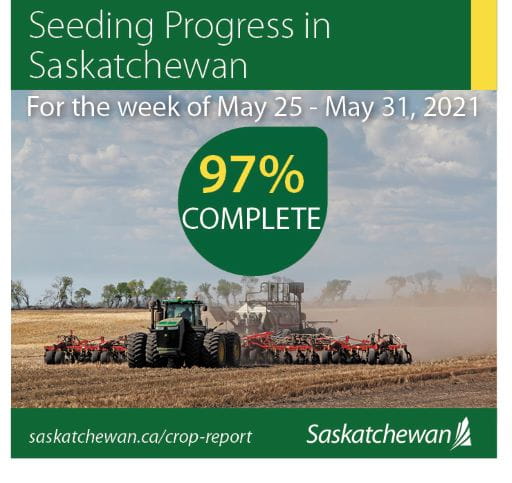Released on June 3, 2021
Dry conditions this week have allowed farmers to nearly complete seeding in all regions of the province. Ninety-seven per cent of the crop is seeded, which is ahead of the five-year average (2016-2020) for this time of year of 92 per cent.
Ninety-eight per cent of the crop is seeded in the southeast, west-central, northeast and northwest regions, 96 per cent in the southwest and 94 per cent in the east-central.
Provincially, ninety-nine per cent of field peas, canary seed and chickpeas, 98 per cent of durum and spring wheat, 96 per cent of barley, flax, canola and soybeans, 95 per cent of lentils and 92 per cent of oats have been seeded to date.
There were small precipitation events throughout the province this week. The Cando area reported the most with 23 mm of precipitation, the Kindersley area reported 20 mm, the Spruce Home area reported 15 mm, the Earl Grey area reported 12 mm and the Rhein area reported 10 mm. This rain was very welcome but more will be needed soon.

Minimal precipitation and strong winds have reduced topsoil moisture conditions in all regions of the province. Rainfall received two weeks ago has helped with pasture conditions in the province, but more is needed. Cropland topsoil moisture is rated as zero per cent surplus, 72 per cent adequate, 20 per cent short and eight per cent very short. Hay and pasture land topsoil moisture is rated as zero per cent surplus, 58 per cent adequate, 29 per cent short and 13 per cent very short.
The majority of crop conditions this week are good. Smaller seed crops, such as canola and mustard, are rated as fair to good. This is mainly due to reduced germination caused by winds and lack of moisture as well as flea beetle pressure. The moisture received over the previous two weeks has allowed later seeded crops to emerge more evenly and earlier seeded crops are now able to develop further. Most crop damage this week was due to strong dry winds, dry soil conditions, flea beetles and gophers.
Now that seeding is almost wrapped up, farmers are busy spraying herbicides, assessing possible frost damage, scouting for early season pests and moving cattle to pasture.
A complete, printable version of the Crop Report is available online at https://www.saskatchewan.ca/crop-report.
Follow the 2020 Crop Report on Twitter at @SKAgriculture.
-30-
For more information, contact:
Matt Struthers
Agriculture
Moose Jaw
Phone: 306-694-3714
Email: matt.struthers@gov.sk.ca
Cell: 306-630-8865

